

|
Home Updates Hydros Cars Engines Contacts Links ←Previous Next→ Contact On The Wire |
Arthur Weaver, Hydroplane Enthusiast
It is not known how Arthur became involved with either tethered hydroplanes or cars, but it is possible that Ernie Clark may have had an influence here as he lived close to the Weavers in Hendon and certainly Arthur had lived very close to Victoria Park for a long while. What is certain is that his approach to tethered hydroplanes was very different to most, although shared by a small group at Victoria. Whilst most were running 30cc or 15cc engines, Arthur, along with Curwen, Heath and Sherwood amongst others used much smaller boats and engines.
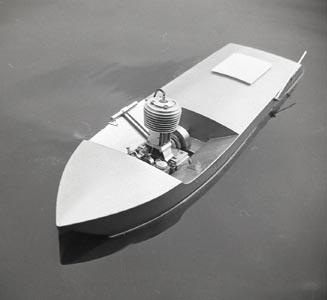 |
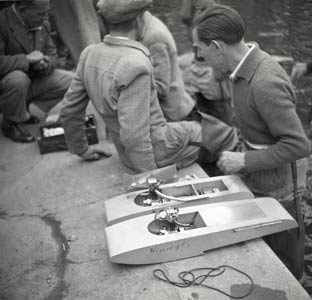 |
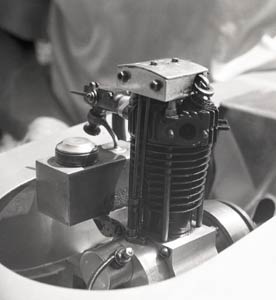 |
| Fleche D'or with a two stroke motor | Wizard of Oz and smaller sister | 10cc OHV twin exhaust motor |
The annual Model Engineer Speedboat Competition divided classes by weight rather than the capacity limits of the MPBA. The delightfully named ‘Fleche D’or’ was a traditional boat shaped hull with a single cylinder two-stroke motor while ‘Wizard of Oz’ had one of a series of 10cc OHV motors that saw service in his boats and cars as well. These motors were beautifully crafted and each had the valve covers engraved with Arthur Weaver and VMSC.
Towards the end of the second war, Victoria introduced an ‘Austerity Class’ for 24" hulls and small motors, almost exactly what Arthur was already doing. ‘Wizard of Oz’ was the most successful of Arthur’s boats both within its own class and against the 15cc B Class boats. He was second in the Miniature Speed Trophy at the International regatta in 1947 and won the ME trophy as the best C Class boat of the season. Several Ist places were recorded by ‘Wizard’ and in one of its last races, 2nd place in the Wico Pacy trophy at the International for boats with home built 10cc motors.
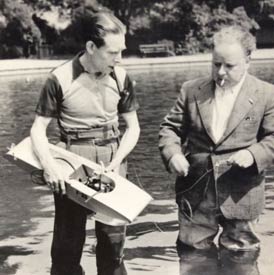 |
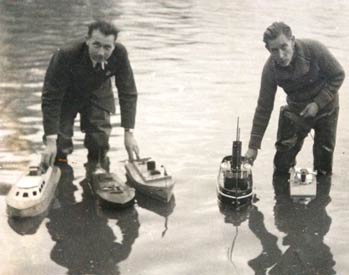 |
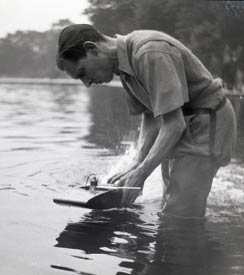 |
| 1944 Arthur with Bert Fort | Arthur with Cyril Drayson | Austerity Class boat |
|
Arthur did not become involved in the out and out search for speed concentrating on the smaller engines, and like other fellow competitors became very involved with the embryo tethered car movement. There is no mention in contemporary magazines of him continuing to run boats after 1949 although his daughter recalls regular family visits to Victoria Park throughout the 50s and 60s. It is presumed that he was using the hydroplanes he was known to have built in the early 1950s, including two using 3.5cc AMCO diesels and another with an ETA29 motor. Right: Victoria Park around 1951, Gwyneth Weaver with her mother Mary and to her left, Olga, Ernie Clark's wife. |
|
The best known of the more modern hydros was a replacement for the original ‘Wizard of Oz’ that had been destroyed, as Gwyneth relates. "It was at Victoria Park, sometime in the mid 50's that The Wizard of Oz broke it's tether, took off and met it's demise when it hit the bank, and I was there to see it happen." The new boat used the same four-stroke motor, which Arthur named ‘Gwyneth’ after his daughter, although a report from the 1960 St Alban's International still calls it 'Wizard of Oz'. Some years after it was built, it won the Willis Cup at the 1974 Model Engineer Exhibition.
|
|
|
These photos reveal that it was not only hydros that Arthur built as his daughter told us that "in the early sixties he built my Mum a "straight runner" because she had said she'd like to "get in the water" but she didn't have much interest in speed."
This also explains the boat seen on the shelves in Pt I |
Tethered Cars take over
The racing of tethered cars became established in the early days of the second war when the MPBA closed down organised hydro racing and all model aeroplane flying banned. Several of the pioneering tethered car builders and runners such as Bob Curwen, Gerry Buck, Jim Cruickshank were also involved with the hydros, and this included Arthur Weaver as well. He did not compete at the inaugural roof top meeting, but was prominent at later events at this unique venue. Although racing hydros under the Victoria banner Arthur ran his cars as a member of the North London SME where he became leader of the car section in 1946.
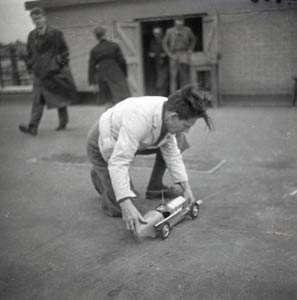 |
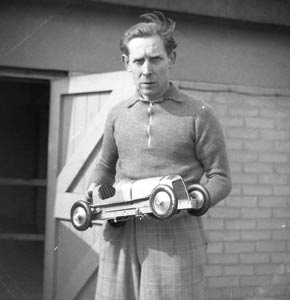 |
 |
| Arthur on the blind factory roof with his first ERA around 1945 | ||
The pioneers of tethered car racing were adamant that cars, although functional, should be based on full sized prototypes, and initially for Arthur these were ERAs. He did produce several versions of the same car, starting with friction drive and then using a conventional gearbox, one rebuild required after the model was nearly destroyed. The number 3 version of this car would serve him well giving him runner up spot in the 1949 Russell trophy at Eaton Bray and winning it in 1950. This trophy awarded points for scale appearance as well as speed. This car also won him the Percival Marshall Presidents Cup at a Pioneer Club meeting in the Horticultural Halls.
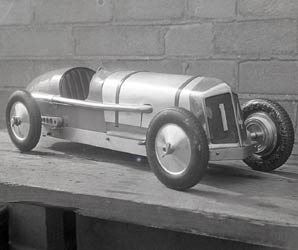 |
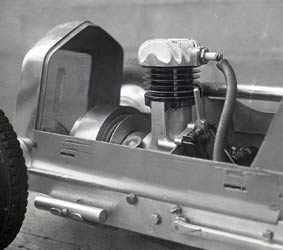 |
 |
| First version of the ERA, near scale with friction drive two stroke motor | ||
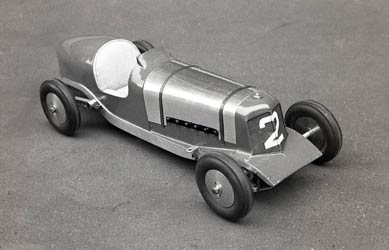 |
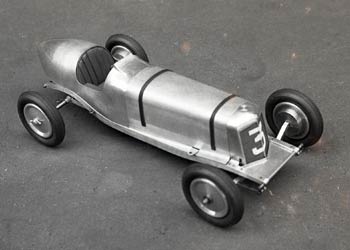 |
| ERA version two ZN wheels and tyres | Version three with 1066 wheels and tyres |
In 1947 the North London Club obtained the use of a tennis court, similar to the Surrey venture and in order to run ‘Mr Weaver had burnt much midnight oil, and in three weeks had thrown some bits and pieces together and called it a car’. (A quote from his own scrapbook).
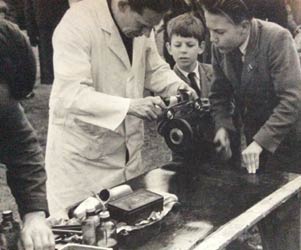 |
 |
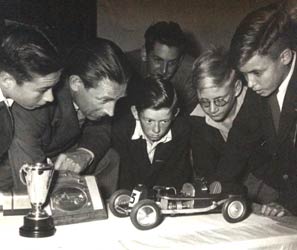 |
| Arthur at the starter | Arthur, Russell Trophy, CW Field, Sutton Trophy | Trophies, ERA and admirers |
Running tethered cars and boats was certainly all consuming as Gwyneth noted. 'When we weren't at a lakeside in summer we were running cars: Eaton Bray when I was very little (Gerry Buck nicknamed me '10cc') and anywhere else a track was being set up as I got older. Model cars and boats were very much a family affair for the Weaver family.'
It is not certain how many tethered cars Arthur built but there followed two versions of the Sunbeam land speed record car, a Delage and a number of others that are known of but cannot now be identified. In the late 1940s, many of the early exponents, including Arthur were becoming disenchanted with the outright pursuit of speed and the move to entirely functional cars, but like others from the Pioneer Club became a total convert to rail racing.
Rail Car Renaissance
Rail tracks had been in existence since the late 1920s, but it was the arrival of the small diesel aero engines that enabled the sport to take off in a big way. Tracks sprung up all across the country with the express intent of making it representative of full sized car racing and with the ability to run several cars at once against each other became exceedingly popular. Indeed, it outlived tethered car racing by another decade or more. Two of the clubs most closely involved were the Raildromers, an offshoot of the Pioneer Club, and the North London SME. Not only was Arthur leader of the car section through to 1950 but also a regular competitor and organiser as well as designing and building cars and engines that became standard equipment for many. A report in Model Maker in 1951 on the opening of the Eight Car Club track in Whetstone states 'The majority of the engines used at the opening meeting were of A.F. Weaver's designs.'
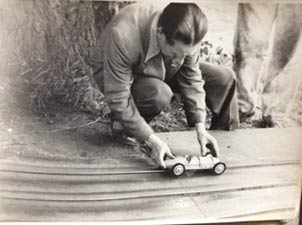 |
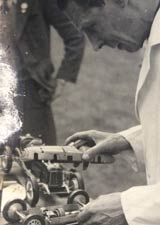 |
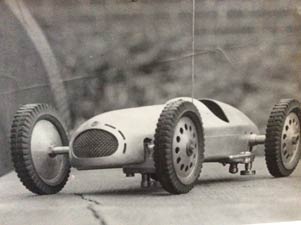 |
| Arthur with one of his first railcars christened Yellow Peril | ||
The photographs above were taken at the first ever meeting of the new NORDROMO circuit in June 1950. Arthur officially handed over the circuit to the NLSME and then competed with 'Yellow Peril'. Clearly to be seen are the rail guides attached to the left of the car in the American style. There was considerable controversy initially and even a court case over the use of Alban Adams' patented 'zonkers' eventually resolved with clubs paying a licence fee to use them so that cars could run on any suitable track although this system required the guides to be mounted centrally under the cars as seen on Arthur's later models. Like all of his work, Arthur's cars and engines were masterpieces of engineering, yet he maintained the scale element in all his cars, often down to a fine level of detail. The prototypes of his cars were instantly recognisable from the models, which included MGs, a Delage, a Hotchkiss Brooklands car, an American Miller, a Vauxhall and an exquisite Cooper Bristol. It is the latter model that he is probably best known for as is related in the next section.
Although he maintained scale bodies, the chassis and works of the cars encompassed vastly different drive trains, suspension and steering including the NL 1952 experimental car that was featured on the cover and described in the March 1953 Model Maker. Arthur built a multitude of small engines for the rail cars with almost every conceivable layout and induction system, including variable timing on the intake.
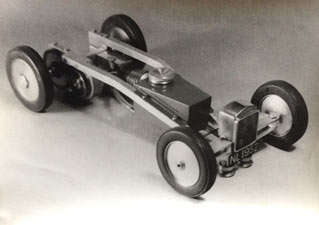 |
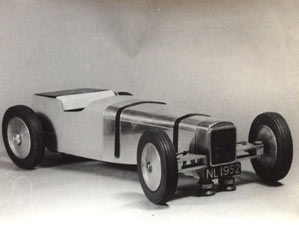 |
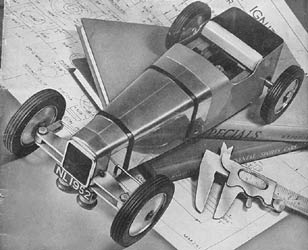 |
Along with fellow club member Bill Ransom, a standard version of his 1cc motor was drawn up with castings being made available for home construction. The machining and building of this motor was serialised in Model Maker in 1952. During 1952, Arthur was again taken ill and spent a considerable period in hospital over the summer, although his scrapbook says he was planning to be back at work in September.
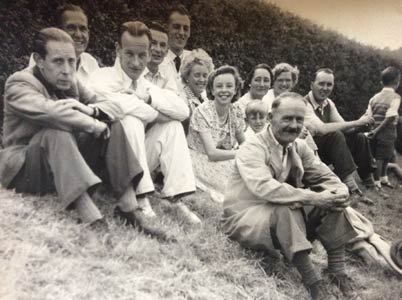 |
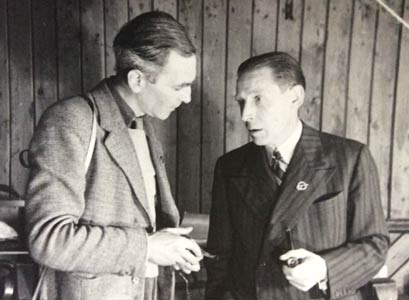 |
| AFW, Alan?,
Chris Thorpe, wife, daughter and son Far left: Mrs Rhodes, Mrs Ransom. In front: Ernie Rhodes, Bill Ransom |
Arthur with NLSME lapel badge in conversation |
At the 1953 ME exhibition Arthur and other NLSME members ran their cars on the 190ft long exhibition rail track and then were asked to compete in a series of races that enthralled the many spectators. For a while Arthur advertised in Model Maker, supplying 2¼" railcar wheels and tyres at 10/- for a set of four. One of his last competitive meetings was in 1954 when he travelled with three other club members down to Alban Adams’ commercial track at Boscombe. Here he won two heats, the semi-final and the final as well as recording the fastest flying lap. For this he received a trophy from Geoffrey Deason, well known author and commentator on model cars. At the NLSME AGM in 54 Arthur gave a presentation on the latest of his builds, and exact copy of Malcolm Campbell’s 1924 Sunbeam, but this is where printed references dry up, apart from retrospective comments in later magazines.
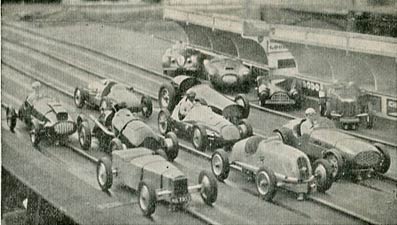 |
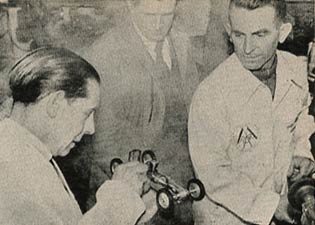 |
| 1953 ME Exhibition NL1952 in foreground | With Alban Adams 1954 |
The Model Engineer
Arthur was probably unique in the world of tethered cars and hydroplanes in that after the second war his hobby was also his business and livelihood. Most of his work falls outside the scope of this article but of particular note were the series of Cooper Bristol replicas commissioned by Wayne Myers of REDeX. Initially two were required with the possibility of more being required for REDeX agents around the world. Arthur used his Cooper Bristol railcar as a basis, enlarging them in proportion to take an ETA 29 glow motor instead of the 1cc Diesel. Otherwise they were scale bodies on a functional chassis so they could be run as tethered cars.
|
|
|
Gearbox and drive train of the Coopers |
In order to make the manufacture of these easier, Arthur resorted to batch production, especially as he had to produce almost every component, including casting the wheels and moulding the tyres. Gwyneth has already mentioned standing at a pillar drill in order to drill the myriad of holes in each of the scale Cooper wheels. He described the production of the first two of these in Model Maker in 1953 and indicating that the run could be as many as six. As well as the commissioned cars finished in their white REDeX livery, Arthur built himself one finished in British Racing Green.
|
|
| Scale front suspension and body parts. Cockpit cut-out is a circle |
His last real involvement with the world of cars, boats and engines appears to have been acting in some sort of consulting capacity to Aeronautical Electronic & Engineering Co of Alperton who had taken over the manufacture of AMCO motors in 1952 from the Anchor Motor Company over in Wales. We know he was working on developing these motors, which included sectioning them to analyse port shapes and amongst his collection was a large selection of motors and parts. This would also account for the two AMCO engined hydros. Arthur was working alongside the famous engine designer Ted Martin during this period and it is one of our regrets that having arranged to meet Ted to discuss this work in more detail he was sadly taken ill and died.
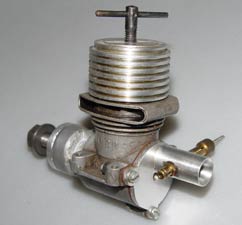 |
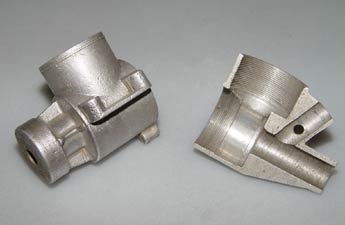 |
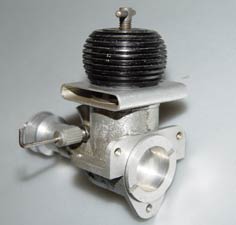 |
| AMCO 3.5BB modified induction | BB casting and sectioned PB casting | Radial mount PB |
Several contacts have spoken of other superb models made by Arthur, including a miniature version of one of his full sized racing trikes around 10" long. We have also had conversations with colleagues of his about the incredible level of skill required to reassemble the Benzole tanker after plating with all the fixings made internally via a narrow slot in the bottom of the tank and specially made tools.
|
In the mid 50s he was commissioned by a silversmith in Ely Place Holborn, to make a track cycling trophy, which was the front third, or so, of a bike. In later years, when he had re-joined the Glendene Cycling Club he designed and made a very similar trophy, The Eric Weaver Track Trophy, which he donated to the club to commemorate his son Eric, killed whist in a cycle race. Model Engineer mentions a fairground carousel built by him, but nothing further is known about that. Right: The Eric Weaver Memorial Trophy |
|
|
Arthur’s daughter described his later life in great detail for us, which brings us back to our first contact with one of his wonderful models, which coincided with his death, although we would not be aware of this for a long while to come.
©copyrightOTW2017